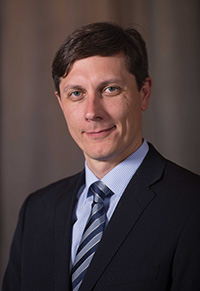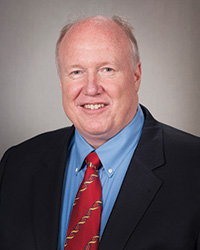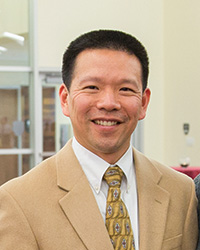Working to Create Healthier Environments
No one knows for sure, but experts estimate there are between a couple of thousand and a couple of tens of thousands of commodity chemicals in the environment. These chemicals satisfy global markets. They are mass produced to manufacture a myriad of end-use products, such as clothes, laundry detergents, and plastics. Commodity chemicals are ubiquitous in the environment, and exposures to some of them have clear effects on human health. “The vast majority of the chemicals that we encounter in our daily life have not been tested for safety,” said Dr. Ivan Rusyn, professor in the Department of Veterinary Integrative Biosciences (VIBS) in the Texas A&M; College of Veterinary Medicine & Biomedical Sciences (CVM) and member of the Texas A&M; University Interdisciplinary Faculty of Toxicology.
Moreover, until recently even chemicals already tested for possible adverse health effects have been studied only from a chemical perspective. That means studies generally have left out the factor of human genetic variability. But, these chemicals in the environment only function in the context of genetics, said Dr. David W. Threadgill, a professor in the Department of Veterinary Pathobiology at the CVM, a professor and the holder of the Tom and Jean McMullin Chair of Genetics in the Department of Molecular & Cellular Medicine at the Texas A&M; Health Science Center College of Medicine, the director of the Texas A&M; Institute for Genome Sciences and Society, and a recently named University Distinguished Professor.
In light of possible health risks due to commodity chemicals and genetic variability, Rusyn and Threadgill collaborate to study how genetics influence health effects related to exposures to single chemicals and other mixtures, like pesticides or petroleum-based substances. “By understanding how the genetics and the environment are interacting, we should have a much better understanding of what actually drives disease processes,” Threadgill said.
Rusyn and Threadgill also work with VIBS professor Dr. Weihsueh A. Chiu, a quantitative risk scientist and former branch chief at the U.S. Environmental Protection Agency (EPA). Chiu integrates experimental data to provide quantitative risk assessments that can be then used for better regulatory decision making. “This partnership between understanding genetics and understanding toxicology is really how the science should be done today-it’s interdisciplinary,” Rusyn said. “The data that [Threadgill] and my lab generate are exactly what [Chiu] needs to inform regulators much better about human health risks and environmental exposures.”
Living in the Chemical World

Rusyn, a toxicologist by training, focuses on people’s variability in their response to chemicals. That means studying not only how exposures to chemicals in the environment can lead to human disease, but also how different individuals might respond differently when exposed to the same chemicals. Rusyn says understanding variability is a key question in regulatory decision making, especially given the lack of experimental evidence. “When you’re trying to protect humans from exposure to a chemical,” he said, “you need to be protecting not just an average person, but also some of the most vulnerable or genetically susceptible.”
Rusyn explained that the EPA establishes safe exposure levels to chemicals. Typically, these are the highest exposures to which a person could be exposed during their lifetime without adverse health effects. The EPA establishes these parameters using laboratory animals that have been exposed to various doses of a particular chemical. However, this approach uses default assumptions to account for individual variability. “What [Threadgill and I] are trying to do in the lab is provide scientific information for each chemical,” Rusyn said. “Then what [Chiu] is trying to do is create new ways in which these data can be incorporated into quantitative risk assessment for regulatory decision making.”
To shed light on how human variability affects adverse responses to chemicals in the environment, Rusyn, formerly at University of North Carolina–Chapel Hill, collaborated with scientists from the National Institutes of Health and geneticists at UNC–Chapel Hill. They conducted the first large-scale experiment to test effects of environmental exposures on cells from a wide range of human populations. In the study, they tried to capture as much genetic diversity as exists in human population. Over 1,000 individuals provided cell lines representing populations from Asia, Africa, Latin America, Europe, and the United States. Then, these cells were exposed to 180 chemicals.
“We wanted to really combine these two dimensions: genetic variability and chemical variability,” Rusyn said. One of the practical applications of this study was that it showed for the first time on such a large scale the limitations of using default assumptions in assessing chemicals’ effects on human health. The study also showed that more experiments could be done to provide chemical-specific information in the nexus between chemistry, genetics, and the environment. “Right now we are regulated by ‘one size fits all,'” Rusyn said. However, some chemicals might need stricter regulations, while for other chemicals the same protection could be provided with less regulation. “We cannot eliminate chemicals,” he said. “This is important so we can help the chemical industry, regulators, and the public to live in the chemical world.”
Considering Genetic Variability
Severity and frequency of health effects due to chemicals in the environment vary from individual to individual. Numerous factors, including heritable traits, life stage, age, health history, nutrition, and psychosocial stress, affect human variability. And different responses to the environment result from the interactions of these and other factors. So, how can scientists begin to understand the connection between human variability and adverse health effects due to chemical exposures?
Threadgill said the first step is to validate the models he has been developing in collaboration with Rusyn, so that the scientific community begins using them. These models will allow scientists to better understand how mammalian systems are programmed. Ultimately, this will determine how genetic networks drive or prevent disease processes, how genetic variations alter these networks, and the role of the environment in altering them.
Threadgill, a geneticist by training, creates animal- and cell-based models to understand how human genetic variability intersects with disease processes influenced by chemicals in the environment. His models are then exposed to chemicals to determine toxicity. “Considering genetic variability as a new parameter, we can clearly show-and have shown-that the variability in response to toxicants or drugs is far greater than what studies with a lack of a genetics angle have shown.” His studies with Rusyn on the toxicological effects of acetaminophen, the active ingredient in Tylenol, have shown that individuals respond differently to it. Even at recommended daily dosing, Threadgill explained, some individuals develop clinical indicators of potential liver damage due to their genotype.
Translating Data

Results from basic discoveries in mouse genetics and experiments in toxicology must be translated to humans before they affect regulation and public health protection. To do that, Chiu uses data generated in Rusyn and Threadgill’s labs to estimate possible adverse health effects under various scenarios.
Chiu specializes in dose response assessment, quantitative statistical modeling, and pharmacokinetics, the science of a chemical’s fate as it enters and eventually leaves the organism. The body breaks down chemicals into different compounds. Analyzing those breakdowns is important, Chiu explained, because those breakdown products might be more toxic than the chemicals to which an individual was originally exposed. To study that, Chiu uses physiologically based pharmacokinetic modeling, a mathematical model that allows him to understand how blood carries chemicals throughout different tissues in the body.
Computer-based models allow Chiu to learn what happens to chemicals inside the body. And to study what chemicals are doing to cells in the body, animal-based and cell-based experiments like those by Rusyn and Threadgill are helpful. These experiments together help to measure different biomedical parameters, like whether an organ is being damaged by certain chemical exposures. “I don’t actually do the experiments, but I take those data and I analyze them mathematically to see what the increase in severity of effects is as you increase exposure,” Chiu said.
For example, Chiu and Rusyn have studied chemicals like trichloroethylene, an industrial solvent commonly used in the electronics industry and detectable in over a Dr. David W. Threadgill thousand superfund and hazardous waste sites across the United States. They also have studied perchloroethylene, the main chemical used for dry cleaning. In their studies, they concluded that trichloroethylene and perchloroethylene, both ubiquitous environmental pollutants, are likely to be carcinogenic to humans. Threadgill, who reached similar conclusions about trichloroethylene in collaboration with Rusyn, followed up with another study to analyze why some individuals seem to be uniquely sensitive to the chemical. That information, Threadgill said, can ultimately be used to help inform other human studies and regulators.
Better Decision Making

Communicating those health-related risks to the public and decision-makers isn’t always an easy task. One of the big challenges, Chiu said, is incorporating new data and modern animal- and cell-based techniques. Rusyn agreed. Because it is impossible to test thousands of chemicals on all human variations, he said non-traditional techniques are the only way to understand human variation and safety of chemicals. Therefore, Chiu’s role is critical, since regulators typically struggle to digest this kind of information. “I take those [data] into computational analysis and translate them into something that a regulator or someone in a state agency can use to help inform their decisions,” he said. “It’s translating data into something that actually will have an impact in society at large to improve protection and public health.”
Another challenge, according to Threadgill, is to encourage the public and decision-makers to appreciate the power of modern techniques in genomics to improve health. “It’s a challenge in a day and age when there seems to be a lot of public resistance to scientific education and really making decisions on scientific facts rather than beliefs or presumptions,” he said.
Further, regulatory decision making faces an urgent need for modernization. United States laws classify chemicals as drugs, pesticides, and commodity chemicals. The U.S. Food and Drug Administration and the EPA have strict regulations for the first two classifications. But commodity chemicals-which make up most of the chemicals in the environment-are a different story. Those chemicals are regulated under the outdated Toxic Substances Control Act (TSCA) of 1976. “Chemicals are chemicals in all of those three categories,” Rusyn said. “Because of how laws are written, the regulatory environments are completely different, even though it could be the same structure if it’s a drug, a pesticide, or something that will be used in a plastic.”
Under TSCA, chemical companies aren’t required to provide detailed information sets about a chemical’s safety. That is, unless the EPA requires them to do so, in which case the EPA needs to explain why chemical companies need to provide more data. Thus, the burden of proof is on the regulators. On the contrary, other laws, like the European Union’s Registration, Evaluation, Authorisation and Restriction of Chemicals, enacted in 2006, require manufacturers to prove their chemicals safe for humans and the environment. In other words, the burden of proof is on the chemical company.
Rusyn, Threadgill, and Chiu’s research aims to contribute to a nationwide collaboration to modernize United States regulations. The EPA and the National Institutes of Health alone screen thousands of chemicals. In this massive effort, Rusyn, Threadgill, and Chiu’s research on human variability will be crucial. “We are the only ones trying to fill this very critical step in the regulatory process, which is understanding or defining how much variability there is in individuals,” Rusyn said.
Collaborating across Disciplines
With this interdisciplinary research in toxicology, genetics, and quantitative health risk assessment, Threadgill believes Texas A&M; is poised to become an international player in the fields of toxicology and risk assessment. Rusyn, who also emphasizes their collaboration’s importance, said they rely on each other to tackle this highly complex problem in public health protection and environmental health. “That’s the concept of the One Health initiative, where you really build a team across different spaces to then solve complex problems,” Rusyn said. Chiu said working across disciplines is an opportunity to make a different kind of impact on public policy. “From academia you can make an impact by providing new methods and data that can be disseminated and used more widely.” He also highlighted the potential for training future practitioners. “Whether it is in the EPA or a state agency, in industry, or in consulting-it’s important to give people a firm foundation not only on fundamental research, but also on how to translate that into actionable information.”
Rusyn, Threadgill, and Chiu recently joined the Texas A&M; College of Veterinary Medicine & Biomedical Sciences as High-Profile Faculty Hires supported by the President’s Senior Hires Initiative and the Chancellor’s Research Initiative. To learn more about them, visit /about-us/crih.


